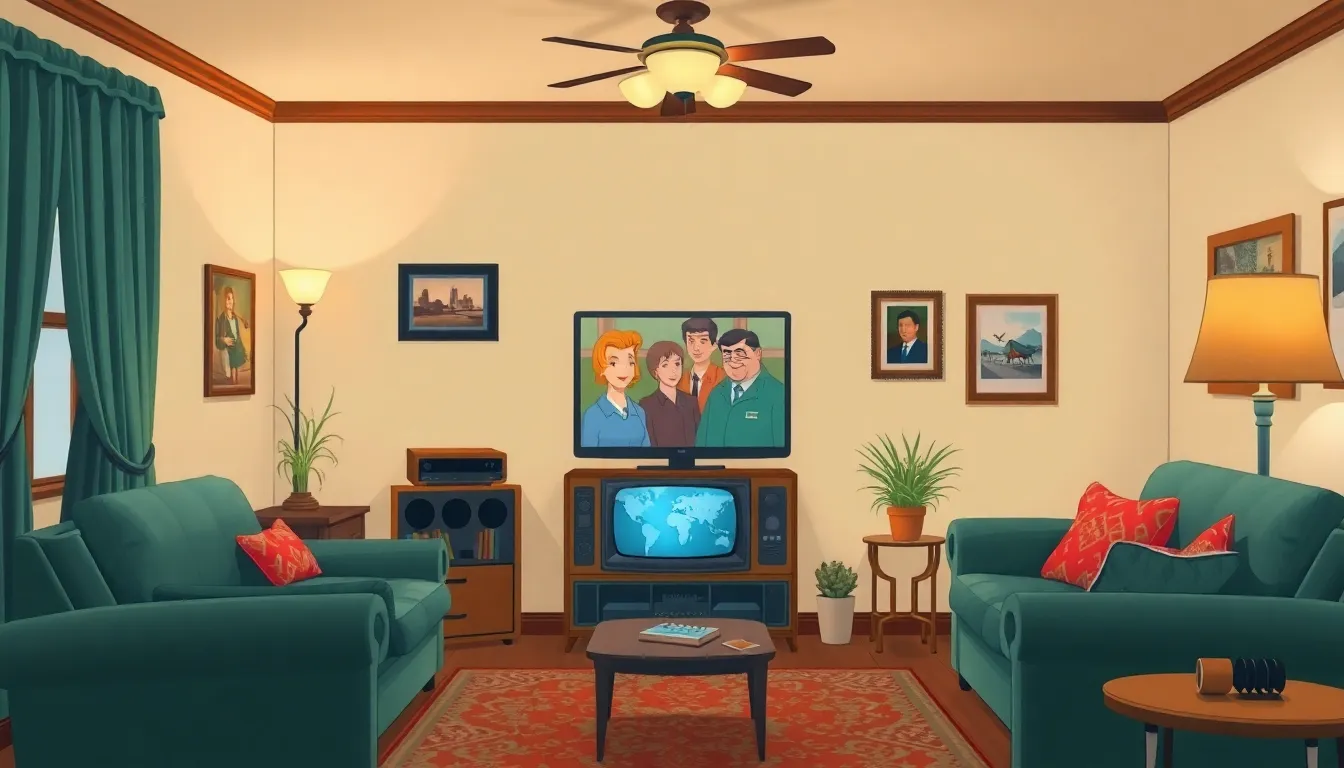Classic TV isn’t just a trip down memory lane; it’s a treasure trove of laughter, drama, and unforgettable characters. From the iconic sitcoms that had families gathered around the television every week to the gripping dramas that kept viewers on the edge of their seats, these shows shaped pop culture and defined eras. Who can forget the quirky antics of Lucy or the misadventures of the gang from “Friends”?
As nostalgia sweeps in like a well-timed laugh track, it’s clear that classic TV still holds a special place in our hearts. Whether you’re a die-hard fan or a curious newcomer, diving into these timeless gems promises a delightful escape. So grab your remote and get ready to binge-watch the shows that made us laugh, cry, and question our life choices—all while wearing questionable fashion choices.
Table of Contents
ToggleWhat Is Classic TV?
Classic TV refers to television shows that gained popularity during earlier decades, specifically from the 1940s to the early 2000s. These series helped shape the television landscape and defined the entertainment culture of their times. Programs often evoke a sense of nostalgia, reminding viewers of simpler days and familiar storylines.
Iconic sitcoms, such as I Love Lucy and The Mary Tyler Moore Show, showcased humor and relatable characters. Dramatic series like MASH* and The Twilight Zone provided thought-provoking narratives and social commentary. These shows not only entertained but also influenced future generations of writers and filmmakers.
Numerous classic TV shows have received critical acclaim, earning various awards and maintaining a loyal fan base. The impact of these programs continues through reruns, streaming services, and merchandise. Audiences consistently rediscover the charm of classic TV, finding comfort in its storytelling and character development.
Viewers often engage with classic TV to escape contemporary challenges, seeking laughs or heartfelt moments. Some enjoy binge-watching entire seasons, while others revisit favorite episodes. Regardless of the format, classic TV resonates with diverse audiences, emphasizing its timeless appeal.
The legacy of classic TV influences modern storytelling, inspiring new programming while retaining key elements of humor and drama. By examining classic TV shows, one can appreciate their cultural significance and understand their role in shaping today’s entertainment.
Iconic Classic TV Shows

Classic TV shows hold a significant place in entertainment history, showcasing unforgettable characters and groundbreaking storytelling. These programs continue to influence contemporary culture and capture audiences’ hearts.
Sitcoms That Defined an Era
I Love Lucy revolutionized the sitcom genre, featuring Lucille Ball’s comedic brilliance and innovative production techniques. The Dick Van Dyke Show brought fresh humor and relatable situations into living rooms across America, thanks to its captivating writing and memorable cast. Cheers combined laughter and heartfelt moments, presenting characters who became beloved friends for viewers. The Mary Tyler Moore Show broke barriers by portraying a single woman in a professional setting, igniting conversations on women’s roles in society. Each sitcom not only entertained but also reflected the social climate of its time, leaving an indelible mark on popular culture.
Dramas That Captivated Audiences
The Twilight Zone invited audiences to explore strange occurrences and moral dilemmas, captivating viewers with its thought-provoking anthology format. MASH* expertly blended comedy with poignant moments, depicting the realities of war through the lives of doctors and nurses in a field hospital. Dallas generated intense drama through its portrayal of power struggles among a wealthy Texas family, setting the stage for future soap operas. The Fugitive kept audiences on the edge of their seats as Dr. Richard Kimble sought justice while evading capture. Each drama provided deep emotional engagement, interpreting human experiences through compelling storytelling.
The Impact of Classic TV on Pop Culture
Classic TV significantly shaped pop culture, influencing countless aspects of modern entertainment. The storytelling techniques, character development, and humor originating from these shows laid the groundwork for today’s television landscape.
Influences on Modern Television
Creativity flourished thanks to classic sitcoms and dramas. Iconic series introduced narrative structures, character archetypes, and humor styles that modern writers adopt. For instance, I Love Lucy set a precedent for sitcoms, inspiring shows like Friends and The Office. Unique comedic timing featured in The Dick Van Dyke Show encourages contemporary programs to blend humor with relatable situations. Quality storytelling, as seen in The Twilight Zone, influences genres like anthology series, prompting new tales exploring societal themes and moral dilemmas. These foundational elements continue guiding writers, proving the lasting influence of classic TV on the ever-evolving industry.
Legacy of Classic TV Characters
Characters from classic TV resonate with audiences even today. Lucille Ball’s Lucy Ricardo paved the way for female leads; her iconic antics became a blueprint for character-driven comedy. Strong female characters like Mary Richards from The Mary Tyler Moore Show challenge traditional roles, empowering future generations. Complex personalities appear consistently in shows like Cheers, where multi-dimensional characters engage viewers on deeper levels. The memorable roles in MASH and Dallas displayed the intricacies of human experience, leaving lasting impressions. Audiences still celebrate these characters, confirming their pivotal role in defining compelling storytelling across eras.
The Evolution of Classic TV Viewing
Classic TV viewing has transformed significantly over the decades. Viewers once relied on traditional broadcast networks to enjoy their favorite shows. This format offered little choice, with scheduled airings dictating when episodes were accessible.
Transition from Broadcast to Streaming
Streaming platforms revolutionized classic TV access. Services like Netflix and Hulu introduced on-demand viewing, allowing audiences to watch entire series at their convenience. Classic shows such as I Love Lucy and The Mary Tyler Moore Show found new life through these platforms. Increased availability led to renewed interest among younger generations. Additionally, viewers can binge-watch favorite series, experiencing memorable moments without waiting for weekly episodes.
Nostalgia and Its Role in Classic TV’s Popularity
Nostalgia significantly fuels the popularity of classic TV. Many viewers associate these shows with cherished memories from their past. Emotional connections foster loyalty to series like Cheers and MASH. By revisiting familiar characters and storylines, audiences find comfort and escapism. This emotional resonance boosts demand for classic reruns and merchandise. Viewers often seek to share their beloved shows with new audiences, creating a cycle of appreciation that transcends generations.
Classic TV shows remain a cherished part of entertainment history. They offer a unique blend of nostalgia and cultural significance that continues to resonate with audiences today. The laughter and drama from these iconic series provide an escape that many find comforting in today’s fast-paced world.
With the rise of streaming services, classic TV is more accessible than ever, allowing new generations to discover the brilliance of shows that shaped modern storytelling. The impact of these programs extends beyond mere entertainment; they’ve influenced social change and inspired countless creators.
As viewers revisit these timeless classics, they not only relive fond memories but also appreciate the artistry that defined an era. Classic TV will always hold a special place in the hearts of those who value storytelling at its finest.



